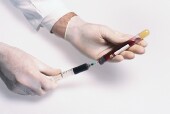Researchers Identify Contaminant in Tainted Heparin
More testing needed to prove that oversulfated chondroitin sulphate caused deaths, reactions.
By Amanda Gardner
HealthDay Reporter
|
E-mail this article
Subscribe to news
Printer friendly version
|

(SOURCES: April 23, 2008, Nature Biotechnology, online; April 24, 2008, New England Journal of Medicine, April 23, 2008, news release, Massachusetts Institute of Technology, Cambridge, Mass.)
WEDNESDAY, April 23 (HealthDay News) -- U.S. researchers say they've confirmed that lots of the blood thinner heparin pulled from the market are contaminated with a man-made chemical called oversulfated chondroitin sulfate.
The findings were published online Wednesday in Nature Biotechnology.
And, according to a paper published online simultaneously in the New England Journal of Medicine, the same researchers state that regulators now have at their disposal a test to detect contaminated heparin.
Regulators have said they have been hampered in their efforts to safeguard the public from contaminated heparin because of an uncertainty over exactly what the contaminant is and the lack of a test to spot such a contaminant.
"Sophisticated analytical techniques enabled complete characterization of the contaminant present in heparin. Further, this study also provides the scientific groundwork for critical improvements in screening practices that can now be applied to monitor heparin, thus ensuring patient safety," Ram Sasisekharan, senior author of the papers and the Underwood Prescott Professor of Biological Engineering and Health Sciences and Technology at Massachusetts Institute of Technology, said in a prepared statement.
On Monday, U.S. health officials said they believed that oversulfated chondroitin sulfate (OSCS) might be responsible for the dozens of deaths and hundreds of adverse reactions in the United States that have been linked with contaminated heparin between roughly last November and February.
That belief was bolstered by the fact that the U.S. Food and Drug Administration said it had identified a likely "biological mechanism" by which the oversulfated chondroitin sulfate leads to the adverse reactions seen so far, Dr. Janet Woodcock, director of the FDA's Center for Drug Evaluation and Research, said at a Monday news conference. Those reactions include difficulty breathing, nausea or vomiting, excessive sweating and falling blood pressure, and life-threatening shock.
However, Woodcock added, "it is very important that we all be confident that we understand the link [between the contaminant and reported illnesses], to ensure that the testing that FDA and others have put in place will prevent further adverse events."
U.S. officials also announced Monday that contaminated heparin products have now been found in at least 10 countries, in addition to the United States. The officials also said contaminated lots of the blood thinner have been traced to 12 different Chinese companies that were somehow involved in heparin manufacture.
Woodcock's announcement seemed to conflict with statements made earlier Monday by Chinese health officials who said oversulfated chondroitin sulfate was not responsible for the reported injuries and deaths.
For the Nature Biotechnology paper, researchers from MIT, the FDA, and elsewhere analyzed six heparin preparations that had been linked with adverse reactions in patients, as well as four "control" preparations not associated with adverse events.
All the preparations linked with adverse reactions contained a contaminant similar to chemically synthesized OSCS, the researchers said. According to the FDA, contaminated heparin has now been linked to as many as 81 deaths and hundreds of injuries in United States.
Armed with information on the chemical structure of the contamination, experts should now be able to distinguish pure heparin from tainted heparin, the study authors stated.
The New England Journal of Medicine paper details a screening test for oversulfated chondroitin sulfate, and also demonstrates that heparin contaminated with OSCS and synthetically-derived OSCS result in side effects in pigs similar to those seen in humans.
Raw heparin is derived from pig intestines, and it's often processed by small, unregistered mom-and-pop workshops in China. Heparin is used for certain types of surgery to prevent blood clots. Kidney patients also take it before undergoing dialysis.
Oversulfated chondroitin sulfate mimics heparin's qualities and is a modified form of chondroitin sulfate. Chondroitin sulfate is a naturally occurring substance made from animal cartilage and is often used in supplements to treat arthritic joints. But, oversulfated chondroitin sulfate is man-made and doesn't occur naturally.
While the reports represent progress, many mysteries still remain, said experts.
"The fact that there's a test available will certainly be helpful and can reassure the public that the heparin being used at their respective hospitals, if a test is being used, is safe. That's good news because heparin is a ubiquitous medication," said Dr. Jack Ansell, a hematologist and chairman of medicine at Lenox Hill Hospital in New York City. "The thing that's still puzzling is is this a natural contaminant or not? We don't know where it's coming from. The nature of the chemical suggests that this is a naturally derived product. If that's the case, it means that it's been inserted or added in some sense, and that still is unclear. We need more information about that."
More information
The U.S. National Library of Medicine has more on heparin.
Copyright © 2008 ScoutNews, LLC. All rights reserved. 
HealthDayNews articles are derived from various sources and do not reflect federal policy. healthfinder.gov does not endorse opinions, products, or services that may appear in news stories. For more information on health topics in the news, visit the healthfinder.gov health library.